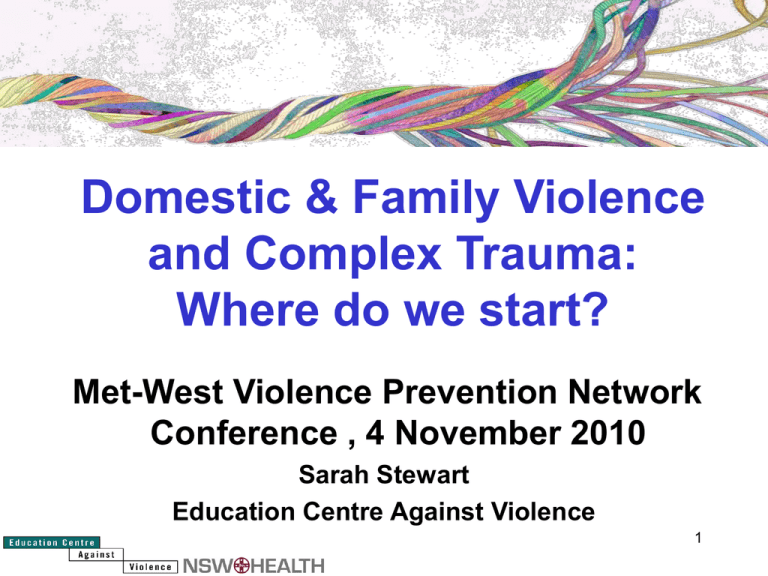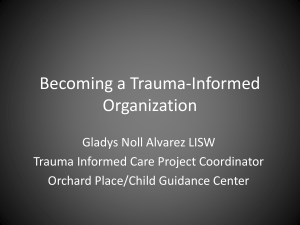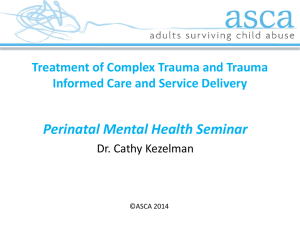Definition of DV (NSW Health)
advertisement

Domestic & Family Violence and Complex Trauma: Where do we start? Met-West Violence Prevention Network Conference , 4 November 2010 Sarah Stewart Education Centre Against Violence 1 • “In order to escape accountability…the perpetrator does everything in his power to promote forgetting. If secrecy fails, the perpetrator attacks the credibility of his victim. If he cannot silence her completely, he tries to make sure no one listens…” • “All the perpetrator asks is that the bystander do nothing…the victim demands action, engagement and remembering…” • “When the truth is finally recognised, survivors can begin their recovery…” (Judith Lewis Herman, Trauma and Recovery,1992) 2 Overview • What are we talking about? • What do we know about the links between domestic & family violence (DFV) and complex trauma? • What are the impacts and outcomes of complex trauma? • What are the implications for practice, policy, training and research? 3 Complex trauma (C-PTSD) • “The experience of multiple, chronic and prolonged developmentally adverse traumatic events, most often of an interpersonal nature…and early life onset” (Bessel van der Kolk, 2005) • “A type of trauma that occurs repeatedly and cumulatively, usually over a period of time and within specific relationships and contexts” 4 (Christine Courtois, 2004) Complex trauma (C-PTSD) • Has a pervasive negative impact and is qualitatively distinct from Post-Traumatic Stress Disorder (PTSD) • A clinically recognised condition (not yet included in the DSM – currently subsumed under ‘Disorders of Extreme Stress Not Otherwise Specified’) • Describes the dual problem of both the exposure to trauma and the impact of the trauma 5 Complex trauma (C-PTSD) • Includes range of traumatic experiences, including DFV and other trauma occurring within context of family and intimate relationships • Also used to refer to other types of catastrophic and entrapping traumatisation in both childhood and adulthood 6 Complex trauma (C-PTSD) • Develops in the context of: – Captivity and lack of means of escape – Entrapment – Repeated violation of boundaries – Betrayal and rejection – Bewilderment and confusion – Lack of control and disempowerment 7 Complex trauma and DFV • Numerous studies of children and adolescents abused and witnessing violence in the context of family relationships describe problems experienced by victim/survivors that do not ‘fit with’ other diagnoses (Scheeringa et al 2003; Van der Kolk et al 2005; Briere 1992) • Complicated adaptations to severe and prolonged trauma have been noted in abused women (Rollstin & Kern 1998; Walker 1984) 8 Complex trauma and DFV • Childhood abuse is the most frequent cause of traumatisation in women (Kessler et al 1995) • All types of childhood victimisation are associated with increased risk of lifetime re-victimisation (Widom et al, 2008) • Among women in violent relationships, depression, drug abuse and a history of childhood abuse increase the likelihood of suicidality - depending on the number of these risk factors involved – 10, 25 and 107 times respectively (Thompson et al 2002 in Koss et al 2003) 9 Complex trauma in children & adolescents • Brain-based stress response -> constant high arousal -> inability to regulate internal states (Perry 2006; van der Kolk 2005) • Defining experience is feeling unsafe -> mistrust of adults (Seita & Brendtro 2005) Enduring negative outcomes across a range of life domains (Kilpatrick et al 2003; Duba et al 2001; Cloitre et al 2001; Felitti et al 1997) BUT…these impacts can be ‘undone’ to an extent (Schore 10 2003) Outcomes of complex trauma in children & adolescents Problems in • Attachment • Biology • Emotional regulation • Dissociation • Behavioural control • Cognition • Self-concept (Cook at al, 2005) 11 Outcomes of complex trauma in women: Alterations in • Regulation of affective impulses • Attention and consciousness • Self perception • Perception of perpetrator • Relationships to others • Physical health • Systems of meaning (Courtois, 2004) 12 An ecological framework (Krug et al, 2002) 13 Intersectionality • Focuses on the interlocking patterns of gender, race, ethnicity, class, disability and sexuality • Analyses social contexts and systems of power and privilege • Acknowledges that trauma may be further amplified and compounded by ‘micro-aggressions’ of racism, heterosexism and classism… 14 (Bograd,1999) Principles of trauma-informed services • Recognise the impact of violence and victimisation on development and coping strategies • Identify recovery from trauma as a primary goal • Employ an empowerment model • Strive to maximise survivor’s choices and control over recovery • Are based in a relational collaboration • Create an atmosphere that is respectful of survivors’ needs for safety, respect and acceptance (Elliott et al., 152005) Principles of trauma-informed services • Emphasise survivor’s strengths, highlighting adaptations over symptoms and resilience over pathology • Work to minimise the possibilities of retraumatisation • Strive to be culturally competent and to understand each survivor in the context of her life experiences and cultural background • Soliciting consumer input and involve consumers in designing and evaluating services 16 (Elliott et al., 2005) Implications for practice • The key elements of a healing relationship: R espect I nformation C onnection H ope (Saakvitne et al, 2000) 17 Implications for practice • The 3 ‘pillars of trauma-informed care’ –Safety –Connections –Managing emotions • You don’t need to be a therapist to be part of the healing process 18 (Bath, 2008) Implications for policy • Policy needs to – reflect explicit links between complex trauma and DFV so that ‘symptoms’ are not misinterpreted as chronic psychopathology – incorporate clear pathways between different service systems and practice areas 19 Implications for training • Need to build a competent and supported trauma-informed workforce through – Single discipline and single agency training tailored to specific practice contexts – Cross-sector and multi-agency training that facilitates coordinated and integrated service provision 20 Implications for research • Need for research that – extends beyond traditional preoccupation with PTSD as an outcome of trauma and pay more attention to multidimensional nature of complex trauma – privileges the voices of survivors and focuses on recovery 21 • “The core experiences of psychological trauma are disempowerment and disconnection from others. Recovery, therefore, is based on the empowerment of the survivor and the creation of new connections” (Judith Lewis Herman, 1992) 22 References • • • • • • • • • • • Bath, H (2008) ‘The three pillars of trauma-informed care’, Reclaiming Children and Youth, 17(3):17-21 Bograd, M (1999) Strengthening domestic violence theories: intersections of race, class, sexual orientation, and gender. Journal of Marital and Family Therapy, 25: 275-289. Briere, J (1992) Child abuse trauma: Theory and treatment of the lasting effects, Newbury Park, CA: Sage Cloitre, M, Cohen, L, Han, H & Edelman, R (2001) ‘Posttraumatic stress disorder and extent of trauma exposure as correlates of medical problems and perceived health among women with childhood abuse’, Women and Health, 34:1-17 Cook, A, Spinazzola, J, Ford, J et al (2005)’Complex trauma in children and adults’, Psychiatric Annals, 35(5):390-398 Courtois, C (2004) ‘Complex trauma, complex reactions: Assessment and treatment’, Psychotherapy: Theory, Research, Practice, Training, 41(4):412-425 Duba, SR, Anda, RF, Felitti, VJ, Chapman, DP, Williamson, DF & Giles, WH (2001) ‘Childhood abuse, household dysfunction and the risk of attempted suicide throughout the lifespan: Findings from the Adverse Childhood Experiences Study’, Journal of the American Medical Association, 286(24): 3089-3096 Elliott, DE, Bjelajac, P, Fallot, RD, Markoff LS & Reed, BG (2005) ‘Trauma-informed or trauma-denied: principles and implementation of trauma-informed services for women’, Journal of Community Psychology, 33(4):461-477 Felitti, VJ, Anda, RF, Nordenberg, D, Williamson, DF, Spitz, AM, Edwards, V et al (1997) ‘Relationship of childhood abuse and household dysfunction to many of the leading causes of death in adults: The Adverse Childhood Experiences Study’, Journal of the American Medical Association, 14: 245-258 Herman, JL (1992a) Trauma and Recovery: The aftermath of violence – from domestic to political terror. New York: Basic Books Herman, JL (1992b) ‘Complex PTSD: A syndrome in survivors of prolonged and repeated trauma’, Journal of Traumatic Stress, 5:377-391 23 References • • • • • • • • • • • • • Kessler, RC, Sonnega, A, Bromet, E, Hughes, M & Nelson, CB (1995) ’Post traumatic stress disorder in the national co-morbidity survey’, Archives of General Psychiatry, 52:1048-1060 Kilpatrick, DG, Ruggeiro, KJ, Acierno, R, Saunders, BE, Resnick, HS & Best, CL (2003) ‘Violence and risk of PTSD, major depression, substance abuse/dependence and comorbidity: Results from the National Survey of Adolescents’, Journal of Consulting and Clinical Psychology, 71:692-700 Koss, MP, Bailey, JA et al. (2003). Depression and PTSD in Survivors of Male Violence: Research & Training Initiatives to Facilitate Recovery, Psychology of Women Quarterly, 27: 130-142. Krug, EG, Dahlberg, L, Mercy, JA, Zwi, A. & Lozano, R. (2002)World Report on Violence and Health, Geneva: World Health Organization. Perry, B (2006) ‘Applying principles of neurodevelopment to clinical work with maltreated and traumatized children’, in Webb (Ed) Working with traumatized youth in child welfare, new York: The Guilford Press Rollstin, AO & Kern, JM (1998) ‘Correlates of battered women’s psychological distress: severity of abuse and duration of the postabuse period’, Psychological Reports, 82(2):387-394 Saakvitne, KW, Gamble, SG, Pearlman, LA & Lev, B (2000) Risking connection: A training curriculum for working with survivors of childhood abuse, Lutherville, MD: Sidran Foundation Press Scheeringa, MS, Zeanah, CH, Meyers, L & Putnam, FW (2003) ‘New findings on alternative criteria for PTSD in preschool children’, Journal of the American Academy of Child and Adolescent Psychiatry, 42(5):561-570 Schore, A (2003) Affect regulation and the repair of the self, New York: W.W. Norton Seita, J & Brendtro, L (2005) Kids who outwit adults, Bloomington, IN: Solution Tree Van der Kolk, B, Roth, S, Pelcovitz, D, Sunday, S & Spinazzola, J (2005) ‘Disorders of Extreme Stress: The Empirical Foundation of a Complex Adaptation to trauma’, International Society for Traumatic Stress Studies, 18(5):289-399 Walker, LE (1984) The battered woman syndrome, New York: Springer 24 Widom, C. Czaja, S & Dutton, M (2008) ‘Childhood victimisation and lifetime revictimisation’, Child Abuse & Neglect, 32: 785-796 Contact details: Sarah.Stewart@swahs.health.nsw.gov.au Ph: 9840 3977 THANK YOU 25









